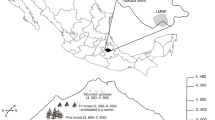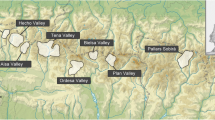Summary
Field observations in a maternity colony of Myotis emarginatus (Vespertilionidae) were made during the summers of 1986 and 1987 in southern Germany. The nursery colony consisted of about 90 adult and 30 juvenile bats which roosted in a dimly lit and relatively cool church attic. Telemetry data from six adult M. emarginatus disclosed that some individuals also use secondary day roosts in trees or small buildings located close to their foraging areas. During the night, radiotagged individuals spent most of the time on the wing in forested areas (Fig. 2). Stationary bouts lasted no longer than 63 min. Individual bats returned to the same foraging areas on consecutive nights. All major foraging areas were situated in or at the fringes of forests, at distances as far as 10 km from the nursery roost. During commuting flights to the forests, M. emarginatus avoided open fields and preferred flight paths which offered cover such as orchards, hedges, overhanging foliage along creeks, etc. On the way to the forests, the bats started to forage within buildings, in open spaces where aggregations of insects were present, and around or within the foliage of various types of trees at the level of tree tops or the upper third of the foliage. At these transient foraging areas close to the maternity roost, M. emarginatus displayed flexible foraging strategies: (1) They gleaned prey (mainly flies and spiders) from the substrate, (2) seized insects in aerial pursuit, and (3) occasionally hovered in front of foliage and walls.
Our observations confirm the conclusion from morphometric data on the wings that M. emarginatus is a predominantly gleaning bat and contradict the suggestion that it makes only brief flights of short distances. On the contrary, our field data suggest that M. emarginatus spends most of the night on the wing and commutes over distances of at least 10 km.
Similar content being viewed by others
References
Ahlen I (1981) Identification of Scandinavian bats by their sonar sounds. Rapp 6 Swed Univ Agric Sci Dept Wildl Ecol, Uppsala
Aldridge HDJN (1986) Manoeuvreability and ecological segregation in the little brown (Myotis lucifugus) and Yuma (M. yumanensis) bats (Chiroptera: Vespertilionidae). Can J Zool 64:1878–1882
Aldridge HDJN, Brigham RM (1988) Loadcarrying and manoeuvreability in an insectivorous bat: a test of the 5% “rule” of radio-telemetry. J Mammal 69:379–382
Aldridge HDJN, Rautenbach IL (1987) Morphology, echolocation and resource partitioning in insectivorous bats. J Animal Ecol 56:763–778
Audet D (1990) Foraging behavior and habitat use by a gleaning bat, Myotis myotis. J. Mammal 71:420–427
Bauerova Z (1986) Contribution to the trophic bionomics of Myotis emarginatus. Folia Zoologica 35:305–310
Calandra V (1986) A study model — the bat colony of Cefalu cathedral in Sicily. Myotis 23/24:239–244
Fenton MB, Bell GP (1979) Echolocation and feeding behaviour in four species of Myotis. Can J Zool 57:1271–1277
Findley JS (1972) Phenetic relationships among bats of the genus Myotis. Syst Zool 21:31–52
Gaisler J (1971) Zur Ökologie von Myotis emarginatus in Mittel-Europa. Decheniana-Beihefte 18:71–82
Habersetzer J, Schuller G, Neuweiler G (1984) Foraging behavior and Doppler shift compensation in echolocating hipposiderid bats, Hipposideros bicolor and Hipposideros speoris. J Comp Physiol 155:559–567
Heinicke W, Krauß A (1978) Zum Beutespektrum des Braunen Langohrs, Plecotus auritus. Nyctalus 1:49–52
Jones G, Rayner JMV (1988) Flight performance, foraging tactics and echolocation in free-living Daubenton's hats, Myotis daubentoni. J Zool 215:113–132
Jones G, Rayner JMV (1989) Foraging behavior and echolocation of wild horseshoe bats Rhinolophus ferrumequinum and Rhinolophus hipposideros (Chiroptera, Rhinolophidae). Behav Ecol Sociobiol 25:183–191
Issel W, Issel B (1953) Zur Verbreitung und Lebensweise der gewimperten Fledermaus, Myotis emarginatus. Säugetierkundl Mitt 1:145–148
König C, Epple A (1957) Die Wimperfledermaus, Myotis emarginatus (Geoffroy, 1806) auch in der Pfalz. Säugetierkundl Mitt 5:123–124
Miller LA, Degn HJ (1981) The acoustic behavior of four species of Vespertilionid bats studied in the field. J Comp Physiol 142:67–74
Neuweiler G (1984) Foraging, echolocation and audition in bats. Naturwissenschaften 71:446–455
Neuweiler G (1990) Auditory adaptations for prey capture in echolocating bats. Physiol Rev 70:615–641
Neuweiler G, Fenton MB (1988) Behaviour and foraging ecology of echolocating bats. In: Nachtigall P (ed) Animal sonar: processes and performances. pp 535–549
Norberg UM, Rayner JMV (1987) Ecological morphology and flight in bats (Mammalia; Chiroptera): wing adaptations, flight performance, foraging strategy and echolocation. Philos Trans Soc Lond [Biol] 316:355–427
Nyholm ES (1965) Zur Ökologie von Myotis mystacinus (Leisl.) und M. daubentoni (Leisl.) (Chiroptera). Ann Zool Fenn 2:77–123
Racey PA, Swift SM (1985) Feeding ecology of Pipistrellus pipistrellus during pregnancy and lactation. I. Foraging behavior. J Anim Ecol 54:205–215
Richarz K (1986) Bedrohung und Schutz der Gebäudefledermäuse. Schriftreihe Bayer Landesamt für Umweltschutz, nr. 73:15–35
Richarz K, Krull D, Schumm A (1989) Quartieransprüche und Quartierverhalten einer mitteleuropäischen Wochenstubenkolonie von Myotis emarginatus (Geoffroy 1806) im Rosenheimer Becken, Oberbayern, mit Hinweisen zu den derzeit bekannten Wochenstubenquartieren dieser Art in der BRD. Myotis 27:111–130
Ruppert K (1987) Wissenschaftliche Ländeskunde, vol 2, Bayern: eine Landeskunde aus sozialgeographischer Sicht. Wissenschaftliche Buchgesellschaft, Darmstadt
Rydell J (1986) Feeding territoriality in female Northern bats, Eptesicus nilssoni. Ethology 72:329–337
Stebbings RE, Griffith F (1986) Distribution and status of bats in Europe. Natural Environment Research Council Institute of Terrestrial Ecology, Huntington
Tuttle MD (1974) An improved trap for bats. J Mammal 55:475–477
Vogler B, Neuweiler G (1983) Echolocation in noctule (Nyctalus noctula) and horseshoe bats (Rhinolophus ferrumequinum). J Comp Physiol 152:421–432
Weid R (1988) Bestimmungshilfe für das Erkennen europäischer Fledermäuse — insbesondere anhand der Ortungsrufe. Beiträge zum Artenschutz 5. Wirbeltiere. Schriftenreihe des Bayerischen Landesamtes für Umweltschutz, nr. 81:63–72
Author information
Authors and Affiliations
Additional information
Offprint requests to: D. Krull
Rights and permissions
About this article
Cite this article
Krull, D., Schumm, A., Metzner, W. et al. Foraging areas and foraging behavior in the notch-eared bat, Myotis emarginatus (Vespertilionidae). Behav Ecol Sociobiol 28, 247–253 (1991). https://doi.org/10.1007/BF00175097
Received:
Accepted:
Issue Date:
DOI: https://doi.org/10.1007/BF00175097




